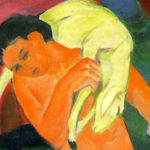We run our website the way we wished the whole internet worked: we provide high quality original content with no ads. We are funded solely by your direct support. Please consider supporting this project.

What are the different models of the Trinity in the Christian tradition?
The Psychological and Social Models of the Trinity
The Bible teaches that there is only one God. At the same time, it teaches that the Father, Son, and Holy Spirit are each fully God. For this reason the church has always affirmed the doctrine of the Trinity, which teaches that God has one substance (ousia) but eternally and fully exists as three distinct Persons (hypostases in Greek, personae in Latin).
The question left unanswered is how we are to understand the relationship between the substantial unity and personal plurality within the Godhead. Throughout church history, two distinct models have been proposed.
The first model goes back to the second-century apologists and was made famous by Augustine. It is usually called the psychological model of the Trinity, for it likens the unity and diversity of the Godhead to the unity and diversity of the human self. According to Augustine, the unity of the Father, Son, and Holy Spirit is like the unity of the mind (thoughts), heart (emotions), and volition (will) of a person. A different version was put forth by Jonathan Edwards in the eighteenth century. He argued that as the human psyche consists of a self, a self-image, and a relationship between the self and the self-image, so the Godhead consists of a self (Father), a perfect self-image (Son), and a perfect loving relationship (Spirit) between the self and the self-image.
While many have found the psychological model helpful, others have objected to it on the grounds that it is not faithful to the biblical data. The Bible depicts the Father, Son, and Holy Spirit as three distinct Persons, they argue, not three distinct aspects of one Person. Hence, they have proposed that we should think of the unity of the Trinity more like the unity of the mind, heart, and will of three people. This has been labeled the social model of the Trinity.
To some defenders of the psychological model, the social model borders on tri-theism (the belief in three separate gods). To some defenders of the social model, the psychological model borders on modalism (reducing the three Persons to three modes of one person). Still others argue that since models are only models, not exact replicas of reality, we may affirm both models as valid in capturing distinct perspectives on a God whose full reality defies exhaustive description.
Related Reading

Insights from a Technology Fast
Hannah Brencher took a two week technology fast and shared what she learned last week. Of course, if you’re reading this, you obviously make use of technology and we’re not saying that there’s anything wrong with that. (We use it an awful lot too.) But there’s a proper place for technology and it’s good to…

The Goal For Your Life in 2015
Love is the reason anything exists. God created the world out of love—to express his love and to invite others to share in his love. The central goal of creation is succinctly summed up in a profound prayer Jesus prayed just prior to his crucifixion: For [the disciples’] sake I sanctify myself, so that they…

Jesus and His Father
Greg addresses a question from a reader about the nature of the Godhead. If Jesus is the exact representation of the Father, what does this mean about the Trinity, if there are indeed three distinct persons?

God Became What He is Not To Reveal What He Is
We are saved because Jesus became the curse of the law for us (Gal. 3:13). So too, the way Christ freed us from the condemnation of sin and enabled us to “become the righteousness of God” was by becoming sin for us (2 Cor. 5:21). What is more, since the curse of the law includes enslavement to…

Forgiveness in the Christus Victor View of the Atonement
Did Jesus need to die on the cross to satisfy God’s wrath in order for us to be forgiven? Greg discusses the role of forgiveness in the Christus Victor view of the Atonement.

Why Did God Require Animal Sacrifice in the Old Testament?
Question: I have a question about the atonement. Why did YHWH in the OT demand that people sacrifice animals? And if these sacrifices anticipated the ultimate sacrifice of the Messiah, as the author of Hebrews says, doesn’t this imply that Jesus’ death was necessary for God to forgive us? But why would God need his…
